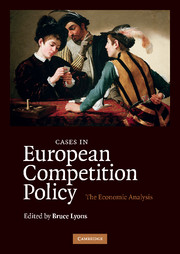Book contents
- Frontmatter
- Contents
- Contents by potentially anticompetitive business practices
- Contents by markets
- List of figures
- List of tables
- List of contributors
- Preface
- Introduction: the transformation of competition policy in Europe
- A Anticompetitive behaviour by firms with market power
- B Agreements between firms
- Introduction
- B.1 Cartels
- B.2 Other horizontal agreements
- 7 Interchange fees in payment card systems: price remedies in a two-sided market
- 8 The Orders and Rules of British Horseracing: anticompetitive agreements or good governance of a multi-sided sport?
- B.3 Vertical agreements
- C Mergers
- Bibliography
- Index
8 - The Orders and Rules of British Horseracing: anticompetitive agreements or good governance of a multi-sided sport?
Published online by Cambridge University Press: 05 June 2012
- Frontmatter
- Contents
- Contents by potentially anticompetitive business practices
- Contents by markets
- List of figures
- List of tables
- List of contributors
- Preface
- Introduction: the transformation of competition policy in Europe
- A Anticompetitive behaviour by firms with market power
- B Agreements between firms
- Introduction
- B.1 Cartels
- B.2 Other horizontal agreements
- 7 Interchange fees in payment card systems: price remedies in a two-sided market
- 8 The Orders and Rules of British Horseracing: anticompetitive agreements or good governance of a multi-sided sport?
- B.3 Vertical agreements
- C Mergers
- Bibliography
- Index
Summary
Introduction
In a sport that is linked with betting and its associated problems, British horseracing is internationally renowned for its quality, diversity and integrity. It is the second most popular sport in Britain, with nearly 6 million spectators watching it live and millions more watching at home, including a TV audience of 10 million for the Grand National each year. Racehorse owners spend £275 million for the excitement of watching their horses race. British horseracing also provides the punter's favourite bet, leaving bookmakers with a gross win of over £1 billion, 10 per cent of which is put back into the sport. It is a key feature of the competitive analysis that three such diverse sets of consumers (spectators, owners and punters) buy into the same British horseracing product. This is the reason for calling it a multi-sided sport in the title to this chapter.
Successful sports are built on strong governance, which is necessary to keep the competition exciting and free from corruption. Sports with weak, fragmented governance structures tend to lose public interest (e.g. boxing, wrestling). The fact that British horseracing has had a unified governance structure for over 250 years is undoubtedly one of the contributing factors to its success. As one might expect over such a long period, a fairly lengthy set of regulations has been developed to govern the rules of individual races and the control of race, fixture and commercial rights.
- Type
- Chapter
- Information
- Cases in European Competition PolicyThe Economic Analysis, pp. 192 - 216Publisher: Cambridge University PressPrint publication year: 2009
- 3
- Cited by

